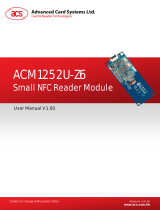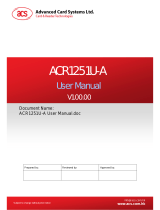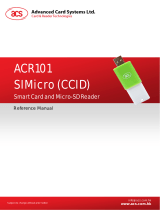Page is loading ...

ACR880 GPRS Portable
Smart Card Terminal
SDK User Manual
Subject to change without prior notice
www.acs.com.hk

Table of Contents
1.0. Introduction ...............................................................................................................4
1.1. Overview................................................................................................................................4
1.2. Typical Applications...............................................................................................................4
2.0. Features .....................................................................................................................5
3.0. Scope and Limitations..............................................................................................6
3.1. Purpose of this Manual..........................................................................................................6
3.2. Applicability............................................................................................................................6
3.3. Embedded Software..............................................................................................................6
3.4. Operating Environment..........................................................................................................6
3.5. How to use this manual .........................................................................................................6
4.0. Getting Started ..........................................................................................................7
4.1. ACR880 Device and its Parts................................................................................................7
4.2. Function Keys........................................................................................................................8
4.3. Connectivity Setup.................................................................................................................9
5.0. Configuring the Device...........................................................................................10
6.0. ACR880 Standalone Demo.....................................................................................12
6.1. Overview..............................................................................................................................12
6.2. Turning the Terminal ON.....................................................................................................12
6.3. POS Demo...........................................................................................................................12
6.4. eHealth Demo......................................................................................................................14
6.5. Loyalty Demo.......................................................................................................................15
6.6. Toggle Backlight..................................................................................................................16
6.7. Turning the Terminal OFF ...................................................................................................16
7.0. eH880 Web Tool ......................................................................................................17
7.1. Overview..............................................................................................................................17
7.2. How to Access the eH880 Web Tool...................................................................................17
7.3. General Tab.........................................................................................................................18
7.3.1. Basic Information ........................................................................................................18
7.3.2. Memory Information....................................................................................................18
7.3.3. Network information....................................................................................................19
7.4. Setting Tab...........................................................................................................................19
7.4.1. Date and Time.............................................................................................................19
7.4.2. Network Configuration ................................................................................................20
7.4.3. Change Password.......................................................................................................20
7.5. Functional Units Tab............................................................................................................20
7.5.1. Select Reader Slot......................................................................................................21
7.5.2. LED and Backlight.......................................................................................................21
7.5.3. Keypad........................................................................................................................21
7.5.4. LCD.............................................................................................................................21
7.5.5. Buzzer.........................................................................................................................21
7.6. Update Firmware Tab..........................................................................................................21
7.6.1. Update Firmware.........................................................................................................22
7.7. Miscellaneous Tab...............................................................................................................22
7.7.1. Upload File..................................................................................................................22
7.7.2. Power Off/Reboot........................................................................................................23
8.0. ACR880 Manuals and Reference Materials...........................................................24
Document Title Here
Document Title Here
Document Title Here
ACR880 CL SDK User Manual
Version 1.0
Page 2 of 24
www.acs.com.hk

Figures
Figure 1: ACR880 Terminal and its Parts.........................................................................................7
Figure 2: ACR880 Terminal and its Parts.........................................................................................7
Figure 3: Connection Ports at the back of ACR880 Terminal..........................................................8
Figure 4: SAM Slots and Reset Button at the back of ACR880 Terminal........................................8
Figure 5: ACR880 Connectivity Setup..............................................................................................9
Figure 6: Configuration Menu.........................................................................................................10
Figure 7: ACR880 Demo Main Menu .............................................................................................12
Figure 8: POS Demo – Administration Menu .................................................................................13
Figure 9: eH880 Web Tool..............................................................................................................17
Figure 10: General Tab.....................................................................................................................18
Figure 11: Setting Tab......................................................................................................................19
Figure 12: Functional Units Tab .......................................................................................................20
Figure 13: Update Firmware Tab......................................................................................................21
Figure 14: Miscellaneous Tab ..........................................................................................................22
Tables
Table 1: File Format and Actions......................................................................................................22
Document Title Here
Document Title Here
Document Title Here
ACR880 CL SDK User Manual
Version 1.0
Page 3 of 24
www.acs.com.hk

1.0. Introduction
1.1. Overview
Smart card technology provides high level of security and cost-
efficient mechanism through a reliable and secure environment to
streamline several operations. Aside from its invulnerability against
tampering and fraud, smart card technology also provides a digital
approach to manage information more easily and effectively.
The ne
w ACR880 is a secure and feature-rich handheld portable
smart card terminal that leverages on the characteristics and
mechanisms of smart card technology. This innovative device is
capable of facilitating secure mutual authentication, detailed multi-
layered information from the cards based on the embedded access
rights, and transactions through both private and public network
infrastructures. It can offer solution to different applications such as:
Healthcare, e-Government, and e-Administration.
The ACR880 Secure Smart Card Terminal Software Development Kit (ACR880 SDK) provides an
effective way of developing customized applications and systems. It serves as an ideal training and
development tool for those who are interested in exploring smart card technologies. The SDK comes
with sample codes written in C programming language. These sample codes showcase the different
capabilities of the ACR880, as well as provide instructions on how to control ACR880 peripherals and
communicate with ISO 7816 and ISO 14443 cards.
1.2. Typical Applications
Electronic Healthcare:
Medical Identification
Digital Signatures
Digital Prescriptions
Patient Data and History
Billing Transactions
Electronic Government
Secure Electronic Payment
Customer Loyalty
Secure Home-banking
Time and Attendance
Document Title Here
Document Title Here
Document Title Here
ACR880 CL SDK User Manual
Version 1.0
Page 4 of 24
www.acs.com.hk

2.0. Features
32-Bit ARM 9 Processor running Embedded Linux
32MB Flash and 32MB SDRAM Memory
Dual Operation Modes (PC-Linked/Standalone)
Long Battery Life for All Day Use
Charging via Docking Cradle
Dual Interface Reader (Contact and Contactless)
USB Host & Client Full Speed/Serial/Ethernet Interface
GPRS/GSM quad band (850, 900, 1800, 1900 MHz)
2 Full-Size Contact Card Slots (Landing Connector)
2 SAM-Size Card Slots (Contact Connector)
Firmware Upgradeable
Hand-held Size and Weight
Easy-to-Read, High Resolution Backlit LCD
Highly Durable Chemical Resistant 20-Button Keypad
4 LED Status Indicators
Built-in Speaker
Tamper Detection Switch to Protect Against Unauthorized Intrusion
Real-Time Clock (RTC) with Independent Backup Battery
Supports Secure PIN Entry (SPE)
Supports PPS (Protocol And Parameters Selection) with 9,600—230,400 Bps In Reading and
Writing Smart Cards
(Optional) Built-in Fingerprint Sensor
(On Request) Wifi
(On Request) Color LCD
(On Request) Internal Microphone
(On Request) Cigarette Lighter Adapter
Document Title Here
Document Title Here
Document Title Here
ACR880 CL SDK User Manual
Version 1.0
Page 5 of 24
www.acs.com.hk

3.0. Scope and Limitations
3.1. Purpose of this Manual
This manual aims to provide the user with relevant information on how to setup and configure
ACR880 terminal as provided in the Software Development Kit. It also instructs the user on how to
execute the SDK demo applications. Further, it provides general information on real-world
applications where the ACR880 terminal may be used.
3.2. Applicability
This manual is only applicable to the ACS ACR880 Software Development Kit.
3.3. Embedded Software
The ACR880 terminal is embedded with Linux 2.6 OS to allow stand-alone operations. This also
allows the device to be operated by a computer (running on Windows, Mac and Linux OS) within the
same network.
3.4. Operating Environment
When used as a stand-alone terminal, the ACR880 device is fully functional with the Pin-Pad for user
input and the LCD screen for display output. The device can be accessed or programmed through a
computer (running on Windows, Mac and Linux OS) using the TCP/IP protocol.
3.5. How to use this manual
This is a comprehensive manual which includes guides on how to use the kit and the provided demos.
Users that are new to the device should read this manual thoroughly. Otherwise, users may directly
proceed to the particular section which needs further reviewing.
Document Title Here
Document Title Here
Document Title Here
ACR880 CL SDK User Manual
Version 1.0
Page 6 of 24
www.acs.com.hk

4.0. Getting Started
4.1. ACR880 Device and its Parts
The ACR880 terminal and some of its essential components are displayed below:
Charging Cradle
LED Status Li
g
ht
LCD Display with Backlight
Cancel / Delete Ke
y
Menu Ke
y
Backs
p
ace Ke
y
Numeric Ke
y
s
Enter / Tick Power ON Key
Contactless Card Reader
Figure 1: ACR8
80 Terminal and its Parts
Card Slot 1
Card Slot 2
Connection Ports
Power Button
Char
g
in
g
Cradle
Figure 2: ACR8
80 Terminal and its Parts
Document Title Here
Document Title Here
Document Title Here
ACR880 CL SDK User Manual
Version 1.0
Page 7 of 24
www.acs.com.hk

USB Client
USB Host RS232
AC Jack
Ethernet
Figure 3: Con
nection Ports at the back of ACR880 Terminal
Card Slot 3
(
SAM
)
Card Slot 4
(
SAM
)
Reset Button
SIM Slot for GPRS
SIM-sized Card
Figure 4: SAM Slots and Re
set Button at the back of ACR880 Terminal
4.2. Function Keys
The ACR880 terminal is equipped with function keys that serve as shortcuts to special device
operations. These function keys are as follows:
F1 is reserved for future use
F2 is reserved for future use
F3 is reserved for future use
F4 is used to display the terminal firmware version, demo version, IP address, date and time.
Document Title Here
Document Title Here
Document Title Here
ACR880 CL SDK User Manual
Version 1.0
Page 8 of 24
www.acs.com.hk

4.3. Connectivity Setup
The ACS ACR880 terminal is a fully-functional device developed for complex applications like Health
Care, Time & Attendance, and Identification. Thus, the terminal is designed to use the TCP/IP
Protocol to communicate with other external devices within a network.
Shown in the diagram below, is the connectivity setup for ACS ACR880:
Router with
Ethernet
Figure 5: ACR8
80 Connectivity Setup
Within the same network, a computer may run applications that can do any of the following:
Use the ACS ACR880 terminal as a smart card reader to read and write data into various
Smart Cards like ACOS, SLE5542, MiFARE, etc.,
Use ACS ACR880 terminal as key input terminal as well as display device for effective user
interaction,
Read and display terminal information and process status, and
Download new software into the ACS ACR880 terminal such as firmware binaries upgrade.
Document Title Here
Document Title Here
Document Title Here
ACR880 CL SDK User Manual
Version 1.0
Page 9 of 24
www.acs.com.hk

5.0. Configuring the Device
To configure the settings of the ACR880 terminal, follow the instructions below:
A. Hold ENTER/TICK (
) key until the screen below is shown.
1 Ethernet…
2 Date/Time
3 Settings…
4 Exit…
Figure 6: Config
uration Menu
B. Select the configuration option from the Configuration Menu. Use Cancel/Cross (
×) key to go
back to the previous menu
The Configuration Menu has different configuration options, these options are as follows:
1. Ethernet
On the Configuration Menu, press 1 for the Ethernet page, here you can choose to fix the IP
of the device or set it to DHCP.
If the Fixed IP option (1) is selected, you will be required to input the desired IP
Address of the terminal, e.g., 192.168.61.123. The user will then be asked to provide
the Subnet Mask, Gateway and the DNS Server addresses. If the user does not
provide any values to these fields, the terminal will generate the following values:
Subnet Mask: 255.255.255.0
Gateway: 192.168.61.1 (consistent to the sample IP address above)
DNS: Not used
If the DHCP option (2) is selected, the ACR880 terminal will obtain its IP Address from
the network. The ACR880 terminal will be accessed or operated from a computer;
hence this computer must be similarly set to obtain its own IP address from the same
DHCP-enabled network. In this manner, the ACR880 terminal and the computer
would belong under the same local area network.
2. Date/Time
On the Configuration Menu, press 2 to input the Date/Time of the device.
1.
F
ixed I
P
2. DHCP
New Date/Time:
_ _ _ _-_ _-_ _ _ _:_ _
Document Title Here
Document Title Here
Document Title Here
ACR880 CL SDK User Manual
Version 1.0
Page 10 of 24
www.acs.com.hk

3. Settings
On the Configuration Menu, press 3 for the Settings page, here you can change the terminal
password and load the default settings of the ACR880 terminal. Use Cancel/Cross (
×) key to
go back to the previous menu.
Load Defaults setting: Press 1 to reset the ACR880 terminal to its factory default
configuration.
Note: German is the default language after the reset.
Change Password setting: Press 2 to change the terminal password.
Note: The default password is 1234.
4. Exit
To leave the Configuration menu, press 4 key and select Save (1), or Without Save (2) from
the menu below.
1.
L
oad Defaults
2. Change
Password
1.
S
ave & Reboot
2. Exit w/o Save
Sav
e & Reboot : Saves the changes made and exits to the remaining booting process
Exit w/o Save : Exits without saving the changes made
Document Title Here
Document Title Here
Document Title Here
ACR880 CL SDK User Manual
Version 1.0
Page 11 of 24
www.acs.com.hk

6.0. ACR880 Standalone Demo
6.1. Overview
The ACR880 Standalone Demo is a preloaded demo application in the ACR880 that consists of many
application programs, demonstrating the multi-slots, contactless, LCD, keypad, buzzer, and other
features of the ACR880 terminal.
The ACR880 Standalone Demo includes the following applications:
POS Demo
eHealth Demo
Loyalty Demo
Supported Card Types:
ACOS3 MCU Card
MIFARE 1K Card
SLE5542 Memory Card
Supported Languages:
English
German
Note: Make sure that no other processes are running while the demo is going on.
6.2. Turning the Terminal ON
Hold ENTER/TICK key () for a few seconds. Wait for the Main Menu to appear as below:
1. POS Demo
2. eHealth Demo
3. Loyalty Demo
4. Toggle Backlight
5. Pwr Off 6. Exit
Figure 7: ACR880 Demo Main Menu
6.3. POS Demo
This demo shows how the ACR880 device can be used for POS applications. To try the demo, follow
the instructions below:
A. On the Main Menu (Figure 6), press 1 to enter the POS Demo.
Select
Transaction
F1: Deb F2: Bal
F3: Cr F4: Admin
Document Title Here
Document Title Here
Document Title Here
ACR880 CL SDK User Manual
Version 1.0
Page 12 of 24
www.acs.com.hk

B. Select transaction type. Follow the screen instruction and present your MiFARE card.
Press F1 to deduct a certain value from the card
Press F2 to check the remaining balance of the card
Press F3 to add a certain value to the card
Credit Amt = 100
Present MiFare
F1: Deb F2: Bal
F3: Cr F4: Admin
Debit Amt = 100
Present MiFare
F1: Deb F2: Bal
F3: Cr F4: Admin
Balance Check
Present MiFare
F1: Deb F2: Bal
F3: Cr F4: Admin
C. The Adm
inistration Menu function allows users to backup the transaction records stored in the
ACR880 terminal. In this demo, ACOS3 card is used as a data collection card. Records are
transferred from the ACR880 terminal to the ACOS3 card.
Press F4 to enter the Administration Menu (Figure 7)
1.
I
ssue ACOS3/2
2. Show Rec POS
3. Show Rec ACOS
4. Xfr Rec-ACOS
5. Leave Admin
0. Exit POS Demo
Figure 8: POS Demo – Administration Menu
Insert an ACOS3 card to card slot 0 or 1. Press 1 to issue a new ACOS3 data collection
card.
Press 2 to show the transaction records stored in the ACR880 terminal, then Clear/Cross
key (
×) to return to the administration menu
Press 4 and then the Enter/Tick () key to transfer all the records from the ACR880
terminal to the ACOS3 card.
Document Title Here
Document Title Here
Document Title Here
ACR880 CL SDK User Manual
Version 1.0
Page 13 of 24
www.acs.com.hk

For example, four records have been transferred from the terminal to the card as shown in the
screen below. And all records in the terminal are cleared.
Xfr Record to ACOS
POS Rec: 40
ACOS Rec: 04
<Enter> to Confirm
<Clear> to Cancel
Press
3 to show the transaction records stored in the ACOS3 card. Press Enter to proceed
to the next record. Press Clear to return to the administration page.
Press 5 to leave the administration page and return the POS demo. Press 0 to leave the
POS demo.
6.4. eHealth Demo
This demo shows how the ACR880 device can be used for eHealth applications. Two pre-initialized
SLE 5542 cards are included in the ACR880 SDK package that you can use with this demo
application. To try the demo, follow the instructions below:
A. On the Main Menu (Figure 6), press 2 to enter the eHealth Demo.
B. Insert a Health Insurance Demo Card (a pre-initialized SLE5542 card) to Card Slot 0 or 1.
Press 1 or 2 to select the card slot to read the card.
C. Health insurance information (Insurance company, insured no., name and address, etc.)
stored in the Health Insurance demo card is shown on the LCD of the ACR880 terminal.
Press any key to proceed with the next data.
Rec #4: SN: 60988244
2008-12-12 00:23:44
Deb=8, Bal=76
Clear: Exit
Enter: Next
Press any key
Insert Card then
Select Card Slot
1. Card Slot 0
2. Card Slot 1
3. Back
HII Name:
ABC Insurance Co.
Document Title Here
Document Title Here
Document Title Here
ACR880 CL SDK User Manual
Version 1.0
Page 14 of 24
www.acs.com.hk

6.5. Loyalty Demo
This demo shows how the ACR880 device can be used Loyalty programs. To try the demo, follow the
instructions below:
A. On the Main Menu (Figure 6), press 3 to enter the Loyalty Demo.
Insert Card then
Select Card Slot
1. Card Slot 0
2. Card Slot 1
0. Back
B. Ins
ert an ACOS3 card to slot 0/1. Press 1 or 2 to select the card slot to read the card.
C. Press 1 to issue a new ACOS3 Loyalty card. Press any key to return to the Loyalty Demo
menu.
D. Press 2 for purchase and insert your ACOS3 Loyalty card. Input the purchase amount using
the key pad (e.g.: 1000) and press Enter.
The purchaser is entitled to an allotment of points which can be used for future purchases.
For every purchase amount of 100, one bonus point is given in this demo.
If you don’t have any Loyalty Points in your card before your first purchase, please press any
key to return to the Loyalty Demo Menu.
ACOS Card Demo
1. Issue Loyalty card
2. Purchase
0. Exit
Issue Card#: 21810
Press any key
Card#: 21810
Loyalty Pts: 0
Purchase
Amount:1000
Use Loyalty Points
0=Yes Others=No
Actual Amt: 1000
Pts. Earned: 10
Press any key
Document Title Here
Document Title Here
Document Title Here
ACR880 CL SDK User Manual
Version 1.0
Page 15 of 24
www.acs.com.hk

E. Press 2 for purchase again. Input the purchase amount using the keypad (e.g.:1000) and
press Enter. Now you can use your loyalty points to do purchase. Press 0 to use loyalty
points. Actual amount to be paid is 990 instead of 1000. Press any key to return to the Loyalty
demo Menu.
Card#: 21810
Loyalty Pts: 10
Purchase
Amount:1000
Use Loyalty Points
0=Yes Others=No
Actual Amt: 990
Pts. Earned: 9
Press any key
F. Press
0 to leave the Loyalty application demo
6.6. Toggle Backlight
Press 3 to turn the backlight of the device ON or OFF.
6.7. Turning the Terminal OFF
Press 4 to turn OFF the terminal on the Main Menu.
Note: Option (5) Exit is reserved for future use only
eH880 Demo
1. POS Demo
2. eHealth Demo
3. Loyalty Demo
4. Pwr Off
5. Exit
Document Title Here
Document Title Here
Document Title Here
ACR880 CL SDK User Manual
Version 1.0
Page 16 of 24
www.acs.com.hk

7.0. eH880 Web Tool
7.1. Overview
The eH880 web tool is an application utility tool preloaded in the ACR880 that enables you to perform
commands to control the device and its peripherals. This tool helps the user identify the basic
information, memory information and network information of the device. This tool also allows the user
to modify the device’s default settings, check the inserted cards in each slot, test the functionality of all
peripherals, update firmware easily and upload any file onto the device for device programming.
Note: For more details, please refer to the Setup Development Environment Manual.
Make sure that no other processes are running when running the web tool.
7.2. How to Access the eH880 Web Tool
To access the tool, make sure that the device is properly connected to the computer via Local Area
Network. Once connected, open your web browser (Mozilla Firefox, Internet Explorer 7) and
navigate to the following address:
Error! Hyperlink reference not valid.
Address of the ACR880 Terminal>
The IP address may also vary depending on the Network Admin. For more information on how to
modify the default IP address, click here
.
To login, use the following default Username and Password:
Username: admin
Password: 1234
Figure 9: eH880 Web Tool
Note: To identify the IP address of the ACR880 terminal, press and hold the F4 key of the device.
Document Title Here
Document Title Here
Document Title Here
ACR880 CL SDK User Manual
Version 1.0
Page 17 of 24
www.acs.com.hk

7.3. General Tab
This tab displays the essential information about the device. It displays the basic, memory and
network information of the device.
Figure 10: General Tab
7.3.1. Basic Information
This shows the following information about the device: current date & time, current firmware version
and current eH880 Tool version.
7.3.2. Memory Information
This shows the current memory information of the device. It can display the device’s basic memory or
advanced memory. It also allows users to refresh the displayed information. Explained below are the
options provided.
Basic: Shows the basic memory information e.g. available, used and total memory space.
Advanced: Shows all memory information e.g. buffers, cache, etc.
Refresh Button: Reloads the current memory information.
Document Title Here
Document Title Here
Document Title Here
ACR880 CL SDK User Manual
Version 1.0
Page 18 of 24
www.acs.com.hk

7.3.3. Network information
This shows the current network connection information of the device. It shows the device’s Terminal
Name, IP Address, Net Mask, Gateway and DNS.
7.4. Setting Tab
This tab allows users to configure the device’s settings. It allows the users to configure the device’s
date & time, network settings, and login password.
Figure 11: Setting Tab
7.4.1. Date and Time
This function is used to set the date and time of the device.
Document Title Here
Document Title Here
Document Title Here
ACR880 CL SDK User Manual
Version 1.0
Page 19 of 24
www.acs.com.hk

7.4.2. Network Configuration
This function is used to configure the network connection of the device i.e. Terminal Name, IP
Address, Net Mask, Gateway and DNS. It also allows you to load the default network configuration of
the device. For the Static IP address, user can manually input the IP address including the Net Mask,
Gateway and DNS while the
DHCP automatically assigns the IP address for the device.
Note: You need to restart the device for the changes to take effect.
7.4.3. Change Password
This function is used to change the login password.
Note: The maximum password length is 8 characters.
7.5. Functional Units Tab
This tab allows the users to check the functionality of all the peripherals of the terminal.
Figure 12: Functional Units Tab
Document Title Here
Document Title Here
Document Title Here
ACR880 CL SDK User Manual
Version 1.0
Page 20 of 24
www.acs.com.hk
/









